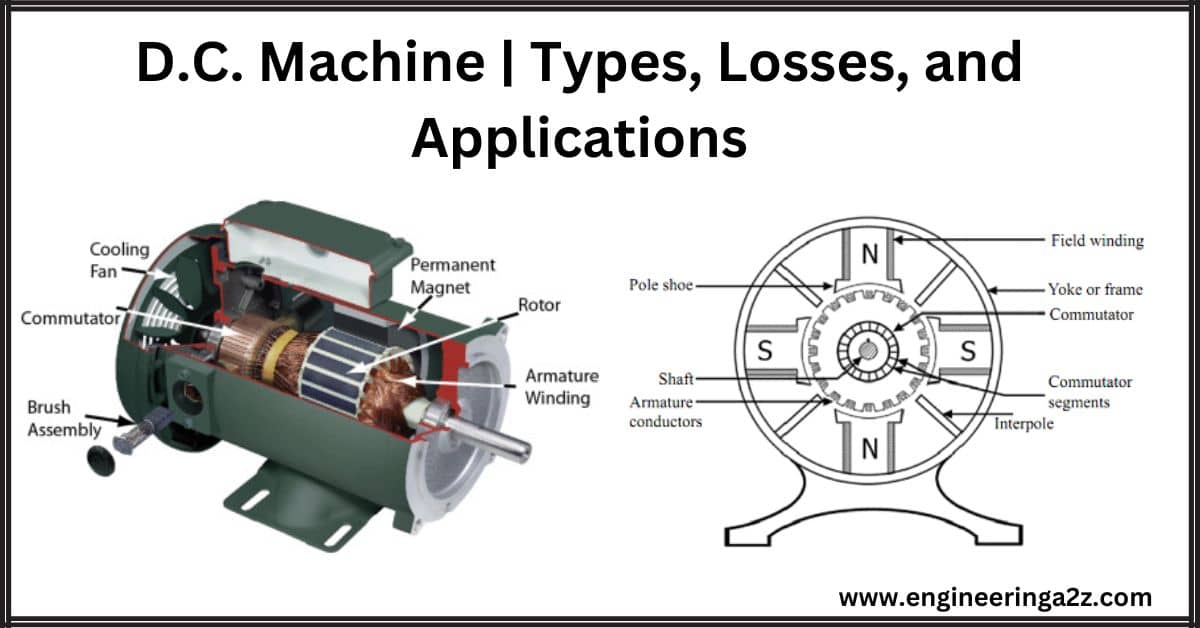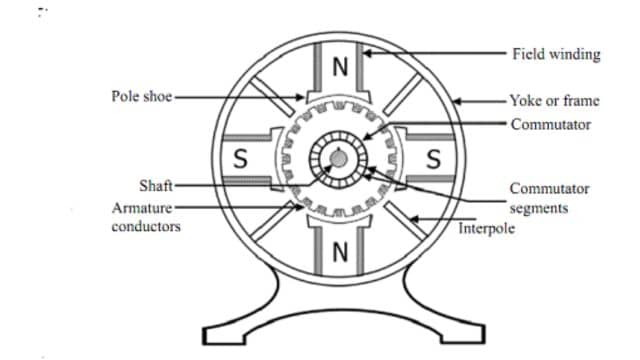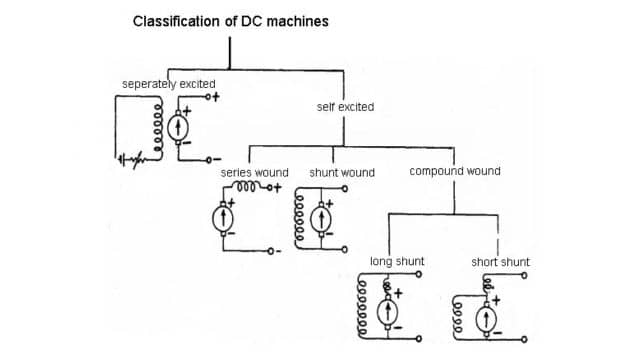
Table of Contents
Introduction
DC machines come in two main types: DC motors and DC generators. They’re a lot like AC machines but also handle AC currents and voltages. Despite this, they provide DC output by converting AC voltage to DC voltage. This conversion is made possible by a part called the commutator, which is why these machines are sometimes called commutating machines.
DC machines are commonly used as motors. They offer advantages like easy speed control and torque regulation. They find use in applications like trains, mills, and mines. For instance, underground trains and trolleys often rely on DC motors. In the past, cars used DC dynamos to charge their batteries.
D.C. Machine
A DC machine is a device that changes energy between electricity and movement. It works like this: When electric current flows through a coil in a magnetic field, it creates a twisting force called torque that makes the DC motor spin. DC machines are divided into two types: DC generators, which produce electricity from motion, and DC motors, which use electricity to create motion.
DC generators turn movement into electric power, while DC motors use electric power to make things move. In industries, we often use AC motors to turn electrical energy into action. But when we need precise speed control and a wide range of speeds, like in electric cars, DC motors are better suited.
Construction Of DC Machine
A DC machine is built using several important parts, each with its own role. Let’s talk about some of these parts:

- Yoke: This is the outermost part and acts as a protective covering. It’s usually made of iron and forms the frame of the machine.
- Pole Core & Pole Shoes: These are parts connected to the yoke, and they help create the magnetic field. The pole shoes are located at the edges of the pole cores and help spread the magnetic field.
- Pole Coil & Field Coil: The pole coil is a winding of wire wrapped around the pole core, and it’s responsible for generating the magnetic field. The field coil, on the other hand, is responsible for supplying electric current to the pole coil.
- Armature Core: This is the central part of the machine and is made of iron. It holds the armature winding and rotates inside the magnetic field.
- Armature Winding (Conductor): The armature winding is a set of coils or wires wound around the armature core. When electric current flows through it, it produces the mechanical movement.
- Commutator: This is an important part that helps convert the AC current generated in the armature winding to DC. It’s a split ring attached to the armature shaft.
- Brushes: These are made of carbon and press against the commutator. They help transfer electric current from the external circuit to the armature winding.
- Bearings: Bearings support the rotating parts of the machine, allowing them to turn smoothly.
Each of these parts plays a crucial role in the operation of a DC machine, allowing it to convert electrical energy to mechanical motion and vice versa.
Types Of DC Machine
DC machine excitation can be divided into two categories: separate excitation and self-excitation. Let’s look at these types and the main kinds of DC machines:
- Separate Excitation: In this type, the field coils receive their electrical power from an independent DC source. It’s like they have their own dedicated power supply.
- Self-Excitation: In this case, the current required for the field winding is supplied by the machine itself. It’s a bit like the machine generates its own field power.

The main types of DC machines are:
- Separately Excited DC Machine: This machine has its field coils powered by an external DC source. The source is separate from the machine itself.
- Shunt-Wound (Shunt) DC Machine: In this type, the field coils are connected in parallel (shunt) with the armature. The machine regulates its own field current.
- Series-Wound (Series) DC Machine: Here, the field coils are connected in series with the armature. The field current is the same as the armature current. This type is often used when high starting torque is needed.
- Compound-Wound (Compound) DC Machine: This one combines the characteristics of both shunt and series machines. There are two sets of field windings: one connected in parallel (shunt) and the other in series with the armature. This type provides a mix of good speed regulation and high starting torque.
EMF Equation Of DC Machine
In a DC machine, like a DC motor or generator, there’s something called electromagnetic induction happening. This means that when you move a magnetic field near a wire, it can create an electric voltage or EMF (electromotive force) in the wire. This is the basis of how these machines work.
The EMF equation of a DC machine describes how this voltage or EMF is related to the machine’s design and operation. In simple terms, the equation looks like this:
EMF = Φ × B × N × Z / 60
- EMF: This is the electric voltage or electromotive force generated in the machine. It’s like the push that makes electric current flow.
- Φ (Phi): This represents the magnetic flux, which is a measure of how much magnetic field is passing through the machine’s coils. More magnetic flux means more EMF.
- B: This stands for the magnetic field strength. It’s a measure of how strong the magnetic field is that’s interacting with the machine’s coils.
- N: This is the number of turns in the coil of the machine. If you have more turns, you can generate more EMF.
- Z: This represents the number of parallel paths in the machine’s armature (the part that rotates in a motor or generates electricity in a generator). More paths can lead to more EMF.
- 60: This is a constant that helps convert the units to the right measurement.
So, in simple words, the EMF equation tells us that the EMF generated in a DC machine depends on how much magnetic field is passing through its coils, how strong that magnetic field is, the number of turns in the coil, the number of paths in the armature, and a constant to make everything work together correctly.
This equation helps engineers and designers understand and predict how much voltage a DC machine can produce based on its characteristics, which is essential for making these machines work effectively in various applications.
Losses In DC Machine
A DC machine’s main job is to change movement into electricity. But not all the power you put in becomes useful electricity – some is lost in various ways. Think of it like some energy disappearing in the process. These losses vary from one machine to another and make the machine less efficient, even raising its temperature. Let’s look at the types of losses in a simpler way:
- Electrical or Copper Losses: When electricity flows through wires, some energy gets lost as heat due to the resistance of the wires. Imagine it like a little bit of energy turning into warmth as the wires do their job.
- Core or Iron Losses: The central part of the machine (core) also loses some energy as heat when it changes the magnetic field. Think of it like a bit of energy going to waste as the core does its work.
- Mechanical Losses: When things move, there’s always some friction and resistance. This makes the machine lose a bit of energy as it turns movement into electricity. Imagine a bit of energy being used up as the parts move against each other.
- Brush Losses: The brushes that touch the spinning part to transfer electricity aren’t perfectly efficient. Some energy is lost here too. Imagine a little bit of energy slipping away where the brushes touch.
- Stray Load Losses: Sometimes, the machine has to fight against external things, like stray magnetic fields. This uses up some energy, even though it’s not part of the main process. Think of it as a bit of energy being used up to battle these external things.
Advantages Of DC Machine
- Rapid Start and Stop: DC motors can begin and halt quickly. It’s like they can speed up rapidly and slow down just as fast.
- Adjustable Speeds: You can easily change their speed by adjusting the voltage they get. It’s like controlling their pace by changing how much power they receive.
- Simple and Affordable: They’re easy to control and cost less than their AC counterparts (like what’s used in homes).
- Precise Speed Management: You can precisely control their speed, like using a remote control to adjust how fast they move.
- Powerful Twisting Force: DC motors provide substantial twisting power, which is useful when dealing with something heavy-duty.
- Smooth Operation: They work smoothly without jerky movements.
- No Strange Electric Patterns: Unlike some other machines, DC machines don’t create odd electrical patterns that can cause issues.
- Effortless Installation and Upkeep: Setting them up and looking after them is easy and doesn’t require a lot of effort.
Application Of DC Machine
- DC motors are used in electric fans, making them spin to create a cooling breeze.
- DC motors power toy cars, making them move forward or backward for playtime fun.
- DC motors help elevators go up and down buildings, carrying people safely.
- DC machines charge batteries in devices like phones and laptops.
- DC motors make treadmills run, helping people exercise indoors.
- DC motors move conveyor belts in factories, helping with production.
- DC machines lift heavy loads in construction sites and docks.
- DC motors drive electric cars, providing eco-friendly transportation.
- DC machines power printers for newspapers and books.
- DC motors help textile machines weave fabrics for clothes.
Frequently Asked Questions (FAQs)
-
What are the main advantages of DC Machines?
1. Strong Starting Power: DC motors have a strong push when they start, thanks to high starting torque. They can get things moving even if they’re heavy.
2. Quick Direction Change: These machines can swiftly switch directions. It’s like going forward and then instantly going backward with no fuss. -
What is EMF in DC?
DC motor’s spinning part makes opposing electricity (back emf) due to magnets. It fights applied voltage, helping the motor run efficiently.
-
What is the back emf formula?
The power from each device is calculated from one of the power formulas based on the given information. The back emf is ϵi=ϵS−I(Rf+REa)=120V−(10A)(2.0Ω)=100V
Read Also:
- Draw and Explain the Construction and Working Principle of DC Motor
- DC Generator | Construction and Working Principle
- Difference Between AC and DC Welding
- Starting Methods of 3-Phase Induction Motor
- Output Equation of an A.C. Machine
- Computer-Aided Electrical Machine Design Notes











Leave a Reply